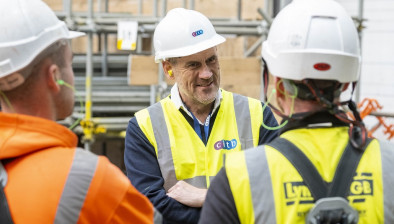Blog: BIM can boost your bottom line – interested now?

Colin Hastie, BIM consultant at Construction Scotland Innovation Centre (CSIC) reveals how BIM can boost the bottom line of a business.
If you’re a business leader in the construction sector, the chances are you’ve heard of BIM. You might even know that despite the common misconception, it isn’t a piece of 3D software – it’s a collaborative process where all parties in a design team work together to deliver a better building for their client.
Quite simply, BIM – or Building Information Modelling - puts all the information that you and your client will ever need about a building into one easily accessible place. It compels the design team to consider the building beyond its handover and gives the client better tools to maintain and operate their building.
Think of the mountain of plans and drawings you would normally give to your client when their building is complete. BIM replaces them all with one accurate, reliable 3D model with information embedded into it – the single source of truth, as some people call it. This model can tell you anything at the touch of a button, from what insulation is in the walls to how often a sensor needs to be cleaned.
You may already have a good understanding of all this, but still be burying your head in the sand and wondering why you should care. What’s in it for your business, other than a big bill for new software and a myriad of staff training requirements?
Construction Scotland Innovation Centre has been offering free BIM workshops and seminars around Scotland for the past year, aimed at everyone from the complete beginner upwards. In my experience, the people who usually attend are the “hands-on” people within a construction business. They go back to the office and tell their managers that BIM is a fantastic idea, but those decision makers aren’t convinced.
Persuading business leaders to adopt BIM can be tricky, because let’s face it, most people don’t like disruption or change. CSIC is on a mission to demystify the process and spell out the business benefits that BIM can bring, like increased productivity and decreased wastage. Add that to the fact that more and more clients are now asking for BIM, and tenders are increasingly listing it as a requirement, and you can start to see why considering BIM might be a good idea.
I believe the trick is to break it down into small, manageable steps. I won’t lie – there is a cost outlay for the software itself, and a training requirement at the start. But once that is in place, the benefits - such as increased productivity - will far outweigh the initial investment.
With BIM, designers work in three dimensions instead of two. The design team, from the architects to the mechanical and electrical engineers, will each work up their own 3D model of the building. Because they are all compatible, these models can be layered on top of each other and exchanged, allowing problems to be spotted and resolved at an early stage, saving time and money.
BIM is also incredibly useful for easily figuring out the consequences of design decisions. If you change the pitch of a roof, for example, the model will tell you instantly how much more or less wall you will need, and the resulting cost implications. You could use the 3D model to calculate how much the sun will heat your building, and how this will change depending on how it is oriented on site. You can accurately predict how much of a material you will need, leading to less wastage. The model can also be adapted for offsite manufacture – and by constructing elements of a building in a factory, you can engineer much greater efficiency.
We’ve just introduced a free e-learning platform to our BIM programme, so if people can’t get along to our workshops and seminars, they can log on and learn about BIM at their own pace. If questions arise, they can join our LinkedIn discussion forum and ask an expert.
Our first e-learning module, available now, is aimed at the complete BIM beginner. The second, which will be added soon, will be crucial as it is aimed at those business leaders who have yet to be persuaded to begin their BIM journey.
So if this means you, watch this space – soon you won’t even need to leave your office to find out why forward-thinking construction businesses are getting clued up on BIM.
To find out more about CSIC’s BIM in Practice programme, and access the e-learning platform, visit http://www.cs-ic.org/bim.














